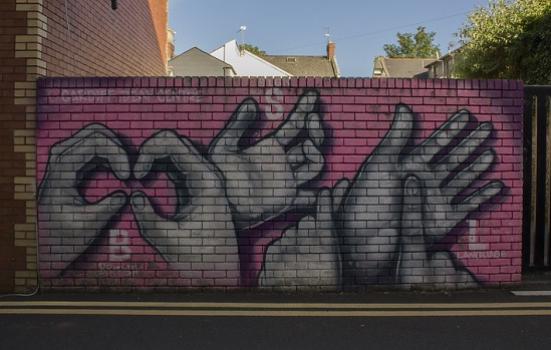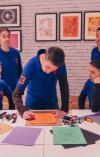If your first and preferred language is British Sign Language, what challenges do you face as a Deaf freelance artist – and what can be done to overcome them? Olivier Jamin shares his experiences and offers some advice.

Jeremy Segrott
With the right support, Deaf people can achieve the same as anybody else – though they may have to work at least three times harder than hearing contemporaries to reach their goals and ambitions. As a Deaf freelance artist working on projects nationally and internationally I face challenges daily. But this doesn’t mean I regret being self-employed. I found working as an employee stifled my creativity: to work on my own terms is much more appealing.
I was born Deaf and am proud to say my first and preferred language is British Sign Language (BSL) – a beautiful, visual language. As a native, I use this language to take advantage of opportunities for face to face conversations, using a registered BSL/English interpreter when necessary. Recently Makaton has been in the news and growing in popularity, which is commendable. But it’s important to note Makaton is very different from BSL. While BSL is a full and rich language with its own grammar, recognised by the UK Government, Makaton provides an aid to communication for those who have learning and/or communication difficulties. It’s a different concept.
Effective communication
Over the years I have been fortunate to receive an Access to Work grant from the Department for Work and Pensions, which has enabled me to network and liaise with business partners using a Registered BSL/English interpreter. Making connections with people out in the field has been invaluable to my career, though peers across the cultural sector can sometimes find it daunting to work with a Deaf, hard of hearing or disabled person. This is often because they are unsure of the practicalities and the perceived ‘right’ and ‘wrong’ way of doing things. In fact it is very straightforward.
When I left school, I was interested in Graphic Design. My careers advisor told me ... I would be best suited to packing boxes in a warehouse.
I and many other Deaf people prefer to meet in person, though I can just as easily communicate with peers by email or telephone, again with interpreter support. But in email correspondence with Deaf BSL native individuals, it’s important to realise that English may not be their first or preferred language so email content should be kept to a minimum, only including the important points to ensure no ambiguity.
If someone isn’t Deaf aware they may first ask whether I can lip read as they don’t understand just how difficult that is. Companies may therefore approach meetings with some trepidation, but the outcome is always positive and relaxed. These meetings even provide an opportunity for them to learn some BSL – though taking an accredited course would be a better way of understanding more about the language.
I would like to see BSL grow in popularity, with more people choosing to learn it. This would be a positive step towards breaking down barriers to communication between Deaf and hearing individuals, putting other Deaf artists like me on the map.
Spreading good practice
To help colleagues improve Deaf awareness, as well as creating and exhibiting art, I offer other services. These include acting as an Accessible Services Consultant; delivering Deaf Awareness Training; running BSL Tours; and creating BSL Videos. Via the Deaf Awareness training sessions, people can better understand and empathise with Deaf, sign language natives like myself. The combination of this and my public engagement art projects, which enable individuals from all backgrounds and abilities to get involved in the creative process of making art, has been extremely rewarding.
If you think the idea of working three times harder to achieve would put me off, you would be wrong. I would like to continue to achieve and become the best Deaf artist there is. When I left school, I was interested in Graphic Design. My careers advisor told me I had three options open to me; College, University or Work, but I would be best suited to packing boxes in a warehouse.
Since working as a freelance artist, I now know there were five options available to me; college, university, work, gap year – or setting up my own business. I hope this article will provide encouragement to the next generation of Deaf and disabled artists, ensuring they are better informed and inspired to chase their goals and ambitions too.
Olivier Jamin is a contemporary freelance artist, winner of the IPSE Freelance Project of the Year Award 2019 and short listed for the European Diversity Awards Coca-Cola Hero of the Year Award, 2019.
www.ojart.net
Instagram: olivierjaminartist




